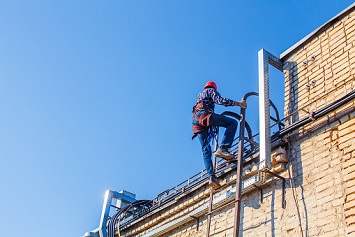November 19, 2018, is a key date for employers with existing outdoor fixed ladders that extend more than 24 feet (ft) above a lower level. Ladders that were erected before that date must be equipped with at least one type of device that protects workers from falling. Ladders erected after November 19, 2018, must meet a higher standard of fall protection.
OSHA spelled out these new requirements in its mammoth final rule amending federal standards for walking-working surfaces and fall protection systems (November 19, 2016, FR). In that rule, OSHA noted that most outdoor fixed ladders are equipped with fall protection systems, but most outdoor fixed ladders used for billboards or outdoor advertising are not. Fixed advertising ladders are commonly equipped with wells or cages, which do provide some stability to workers; but it is generally recognized that cages or wells do not prevent falls. Therefore, one intent of the final rule is to phase out the use of cages and wells as “fall protection.”
Consistent with Construction Standards
Specifically, the final rule gives employers with existing ladders that have only cages or wells until 2036 to ensure that such ladders are equipped with ladder safety or personal fall arrest systems. Given that the life of an outdoor fixed ladder is about 20 years, the provision essentially allows owners and employers to wait until they must purchase a new ladder system before coming into compliance. Also, employers with outdoor fixed ladders that have no protections at all have until November 19, 2018, to ensure that their ladders have at least one of four devices: a cage, a well, a ladder safety system, or a personal fall arrest system. According to OSHA, one intent of the rule was to make existing general industry standards for walking-working surfaces more consistent with existing construction standards.
Performance-Based Requirements
OSHA states that the requirements in the rule are performance-based, meaning that while employers must meet a safety standard for workers, they are not required to install specific equipment. The key definitions in the rule reflect this:
- Ladder safety systems—a system designed to eliminate or reduce the possibility of falling from a fixed ladder. A ladder safety system usually consists of a carrier (i.e.,a flexible cable or rigid rail track), a safety sleeve (i.e.,a moving component that travels up and down on the carrier), lanyard, connectors, and body harness. Cages and wells are not considered ladder safety systems.
- Personal fall arrest system—a system used to arrest an employee in a fall from a walking-working surface. It consists of a body harness, anchorage, and connector. The means of connection may include a lanyard, deceleration device, lifeline, or a suitable combination of these.
OSHA believes that employers that have no fall protection at all on ladders subject to the rule will choose to install ladder safety systems or personal fall arrest systems before the November 2018 deadline since these systems are less expensive than cages or wells.
Billboard Ladders
As noted, OSHA expressed particular concern about the state of outdoor advertising ladders and the level of safety they provide. Currently, employers are required to install fall protection (i.e., ladder safety systems) only where the length of a climb exceeds 50 ft, or the height of the ladder extends more than 65 ft above grade. Here are two additional points about how the rule addresses billboard ladders:
- Qualified climbers may continue to climb billboard fixed ladders (over 24 ft) without fall protection during the 2-year phase-in period for installing some type of fall protection on those ladders.
- The final rule phases out OSHA’s 1993 policy that allows qualified climbers to climb billboard fixed ladders without any fall protection. Once phase-in deadlines arrive, outdoor advertising employers must ensure that all billboard fixed ladders (over 24 ft) are equipped with fall protection and that all workers use those systems during the entire length of the climb.
OSHA’s information page on the final rule is at https://www.osha.gov/walking-working-surfaces/index.html.

